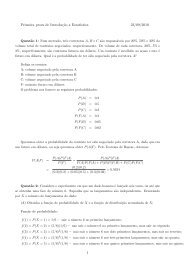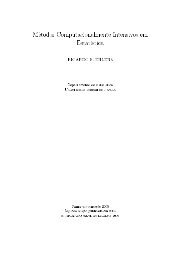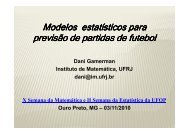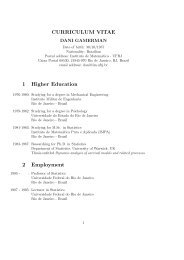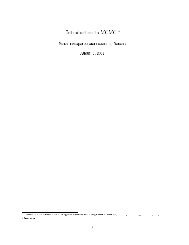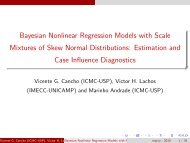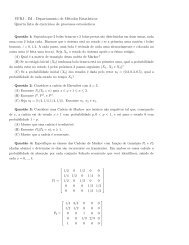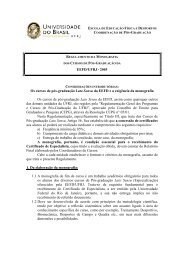Copulas: a Review and Recent Developments (2007)
Copulas: a Review and Recent Developments (2007)
Copulas: a Review and Recent Developments (2007)
You also want an ePaper? Increase the reach of your titles
YUMPU automatically turns print PDFs into web optimized ePapers that Google loves.
Let R u = P nj=1 IfU j · ug <strong>and</strong> R v = P nj=1 IfV j · vg. In Barakat (2001) propertiesof joint distribution (R u ;R v ) are investigated, <strong>and</strong> as consequences, limitingdistribution results are obtained for the vector (X r:n ;Y s:n )where1· r; s · n. For¯xed r; s ¸ 1, as n !1,thepair(r; s) is called ¯xed rank (or the case of extremeorder statistics). When r; s !1as n !1,(r; s) is called increasing rank. Oneparticular rate of increase of special interest is when r n ! ¸1 <strong>and</strong> s n ! ¸2 as n !1such that 0 · ¸1;¸2 < 1or¸1 =0;¸2 = 1. Additionally, nine other cases coveringthe possible asymptotic distributions of bivariate order statistics are presented. Weconsider only the increasing rank case, but the method elaborated can be appliedsimilarly for the remaining cases.In Anjos et al. (2005) we extract the asymptotic copula, denoted by C a ,fromthelimiting distribution of (R u ;R v ) <strong>and</strong> use the corresponding approximation to evaluatethe joint distribution function of order statistics (X r:n ;Y s:n ); as follows.Theorem (weak convergence, Anjos et al. (2005)). Let min ¡ n ¡ r; r ¢ !1<strong>and</strong> min ¡ n ¡ s; s ¢ !1when n !1. Furthermore, let r n ! ¸1 <strong>and</strong> s n ! ¸2 asn !1such that 0 · ¸1;¸2 < 1 or ¸1 =0<strong>and</strong> ¸2 =1.Ifr ¡ nupnu(1 ¡ u)! ¿ 1<strong>and</strong>s ¡ nvpnv(1 ¡ v)! ¿ 2hold for given u; v 2 (0; 1) <strong>and</strong> ¯xed constants ¿ 1 <strong>and</strong> ¿ 2 , <strong>and</strong> additionally½ Ru ;R v= Corr(R u ;R v ) n !1 ¡¡¡¡¡¡¡¡! ½;thenÃPR u ¡ nupnu(1 ¡ u)·r ¡ nu pnu(1 ¡ u);R v ¡ nvpnv(1 ¡ v)·!p s ¡ nvnv(1 ¡ v)d ¡¡¡¡¡!n !1 © ½ (¿ 1 ;¿ 2 );where © ½ is the joint distribution function of bivariate normal distribution with zeromean vector <strong>and</strong> correlation coe±cient ½ = pC(u;v)¡uv¥uv(1¡u)(1¡v)Since C(w; t) =H(F ¡1 (w);G ¡1 (t)), the asymptotic copula C a of (R u ;R v )isgivenby C a (w; t) =© ½ (© ¡1 (w); © ¡1 (t)) <strong>and</strong> the corresponding survival copula has the formC a (w; t) =© ½ (© ¡1 (w); © ¡1 (t)):Under conditions in last theorem H Ur:n;Vs:n (u; v) can be approximated byµµ H Ur:n;Vs:n (u; v) ¼ © ½ ©µ¯r;n¡r+1 ¡1 (u); © ¡1 ¯s;n¡s+1 (v) ;since H Ur:n ;V s:n(u; v) =H Ru ;R v(r; s). Using the well know relation C(w; t) =w +t ¡ 1+C(1 ¡ w; 1 ¡ t) whereC(w; t) is the survival copula, we obtain the following21




